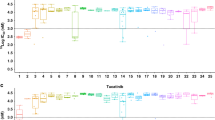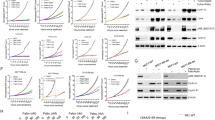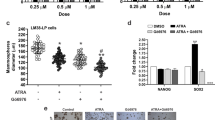Abstract
All-trans retinoic acid (ATRA), the only clinically available cyto-differentiating agent, has potential for the therapy/chemoprevention of breast carcinoma. Given the heterogeneous nature of this tumor, a rational use of ATRA and derivatives (retinoids) in the clinic requires the identification of patients that would benefit from retinoid-based protocols. Here, we demonstrate that 23–32% of the human ERBB2+ breast cancers show coamplification of retinoic acid receptor alpha (RARA), encoding the retinoic acid receptor, RARα. This represents a novel subtype of breast cancer characterized by remarkable sensitivity to ATRA and RARα agonists, regardless of positivity to the estrogen receptor, a known modulator of retinoid sensitivity. In estrogen-receptor-negative cellular models showing coamplification of ERBB2 and RARA, simultaneous targeting of the corresponding gene products with combinations of lapatinib and ATRA causes synergistic growth inhibition, cyto-differentiation and apoptosis. This provides proof-of-principle that coamplification of ERBB2 and RARA can be exploited for the stratified and targeted therapy of a novel subtype of breast cancer patients, with an approach characterized by tumor cell selectivity and low predicted toxicity. The available cellular models were exploited to define the molecular mechanisms underlying the antitumor activity of combinations between lapatinib and ATRA. Global gene expression and functional approaches provide evidence for three components of the antiproliferative/apoptotic responses triggered by lapatinib+ATRA. Induction of the retinoid-dependent RARRES3 protein by ATRA stabilizes the effect of lapatinib inhibiting ERBB2 phosphorylation. Upregulation and activation of the transcription factor FOXO3A integrates ATRA-dependent transcriptional and lapatinib-dependent posttranscriptional signals, controlling the levels of effector proteins like the antiapoptotic factor, BIRC5. Stimulation of the TGFβ pathway by ATRA mediates other components of the apoptotic process set in motion by simultaneous targeting of ERBB2 and RARα.
This is a preview of subscription content, access via your institution
Access options
Subscribe to this journal
Receive 50 print issues and online access
$259.00 per year
only $5.18 per issue
Buy this article
- Purchase on Springer Link
- Instant access to full article PDF
Prices may be subject to local taxes which are calculated during checkout






Similar content being viewed by others

References
Abramson V, Arteaga CL . (2011). New strategies in HER2-overexpressing breast cancer: many combinations of targeted drugs available. Clin Cancer Res 17: 952–958.
Afonja O, Juste D, Das S, Matsuhashi S, Samuels HH . (2004). Induction of PDCD4 tumor suppressor gene expression by RAR agonists, antiestrogen and HER-2/neu antagonist in breast cancer cells. Evidence for a role in apoptosis. Oncogene 23: 8135–8145.
Aryee MJ, Gutierrez-Pabello JA, Kramnik I, Maiti T, Quackenbush J . (2009). An improved empirical bayes approach to estimating differential gene expression in microarray time-course data: BETR (Bayesian Estimation of Temporal Regulation). BMC Bioinformatics 10: 409.
Balmer JE, Blomhoff R . (2002). Gene expression regulation by retinoic acid. J Lipid Res 43: 1773–1808.
Balmer JE, Blomhoff R . (2005). A robust characterization of retinoic acid response elements based on a comparison of sites in three species. J Steroid Biochem Mol Biol 96: 347–354.
Barral PM, Sarkar D, Su ZZ, Barber GN, DeSalle R, Racaniello VR et al. (2009). Functions of the cytoplasmic RNA sensors RIG-I and MDA-5: key regulators of innate immunity. Pharmacol Ther 124: 219–234.
Baselga J . (2006). Targeting tyrosine kinases in cancer: the second wave. Science 312: 1175–1178.
Baselga J, Swain SM . (2009). Novel anticancer targets: revisiting ERBB2 and discovering ERBB3. Nat Rev Cancer 9: 463–475.
Buck MB, Knabbe C . (2006). TGF-beta signaling in breast cancer. Ann NY Acad Sci 1089: 119–126.
Chambon P . (1996). A decade of molecular biology of retinoic acid receptors. FASEB J 10: 940–954.
Colombo V, Lupi M, Falcetta F, Forestieri D, D′Incalci M, Ubezio P . (2011). Chemotherapeutic activity of silymarin combined with doxorubicin or paclitaxel in sensitive and multidrug-resistant colon cancer cells. Cancer Chemother Pharmacol 67: 369–379.
Danforth Jr DN . (2004). All trans-retinoic acid acts synergistically with hydroxytamoxifen and transforming-growth factor beta to stimulate apoptosis in MCF-7 breast cancer cells. J Endocrinol 183: 395–404.
Decensi A, Bonanni B, Guerrieri-Gonzaga A, Torrisi R, Manetti L, Robertson C et al. (2000). Chemoprevention of breast cancer: the Italian experience. J Cell Biochem Suppl 34: 84–96.
Dokmanovic M, Chang BD, Fang J, Roninson IB . (2002). Retinoid-induced growth arrest of breast carcinoma cells involves co-activation of multiple growth-inhibitory genes. Cancer Biol Ther 1: 24–27.
Dusek RL, Attardi LD . (2011). Desmosomes: new perpetrators in tumour suppression. Nat Rev Cancer 11: 317–323.
Esteva FJ, Yu D, Hung MC, Hortobagyi GN . (2010). Molecular predictors of response to trastuzumab and lapatinib in breast cancer. Nat Rev Clin Oncol 7: 98–107.
Fitzgerald P, Teng M, Chandraratna RA, Heyman RA, Allegretto EA . (1997). Retinoic acid receptor alpha expression correlates with retinoid-induced growth inhibition of human breast cancer cells regardless of estrogen receptor status. Cancer Res 57: 2642–2650.
Garattini E, Gianni M, Terao M . (2007). Retinoids as differentiating agents in oncology: a network of interactions with intracellular pathways as the basis for rational therapeutic combinations. Curr Pharm Des 13: 1375–1400.
Garattini E, Parrella E, Diomede L, Gianni M, Kalac Y, Merlini L et al. (2004). ST1926, a novel and orally active retinoid-related molecule inducing apoptosis in myeloid leukemia cells: modulation of intracellular calcium homeostasis. Blood 103: 194–207.
Gianni M, Boldetti A, Guarnaccia V, Rambaldi A, Parrella E, Raska Jr I et al. (2009). Inhibition of the peptidyl-prolyl-isomerase Pin1 enhances the responses of acute myeloid leukemia cells to retinoic acid via stabilization of RARalpha and PML-RARalpha. Cancer Res 69: 1016–1026.
Gianni M, Li Calzi M, Terao M, Guiso G, Caccia S, Barbui T et al. (1996a). AM580, a stable benzoic derivative of retinoic acid, has powerful and selective cyto-differentiating effects on acute promyelocytic leukemia cells. Blood 87: 1520–1531.
Gianni M, Terao M, Gambacorti-Passerini C, Rambaldi A, Garattini E . (1996b). Effects of 1,25-dihydroxy vitamin D3 on all-trans retinoic acid sensitive and resistant acute promyelocytic leukemia cells. Biochem Biophys Res Commun 224: 50–56.
Gianni M, Zanotta S, Terao M, Garattini S, Garattini E . (1993). Effects of synthetic retinoids and retinoic acid isomers on the expression of alkaline phosphatase in F9 teratocarcinoma cells. Biochem Biophys Res Commun 196: 252–259.
Guha M, Plescia J, Leav I, Li J, Languino LR, Altieri DC . (2009). Endogenous tumor suppression mediated by PTEN involves survivin gene silencing. Cancer Res 69: 4954–4958.
Huang SL, Shyu RY, Yeh MY, Jiang SY . (2000). Cloning and characterization of a novel retinoid-inducible gene 1(RIG1) deriving from human gastric cancer cells. Mol Cell Endocrinol 159: 15–24.
Hudis CA . (2007). Trastuzumab—mechanism of action and use in clinical practice. N Engl J Med 357: 39–51.
Kastner P, Mark M, Chambon P . (1995). Nonsteroid nuclear receptors: what are genetic studies telling us about their role in real life? Cell 83: 859–869.
Koay DC, Zerillo C, Narayan M, Harris LN, DiGiovanna MP . (2010). Anti-tumor effects of retinoids combined with trastuzumab or tamoxifen in breast cancer cells: induction of apoptosis by retinoid/trastuzumab combinations. Breast Cancer Res 12: R62.
Lupi M, Matera G, Branduardi D, D′Incalci M, Ubezio P . (2004). Cytostatic and cytotoxic effects of topotecan decoded by a novel mathematical simulation approach. Cancer Res 64: 2825–2832.
Mariani G, Fasolo A, De Benedictis E, Gianni L . (2009). Trastuzumab as adjuvant systemic therapy for HER2-positive breast cancer. Nat Clin Pract Oncol 6: 93–104.
McEarchern JA, Kobie JJ, Mack V, Wu RS, Meade-Tollin L, Arteaga CL et al. (2001). Invasion and metastasis of a mammary tumor involves TGF-beta signaling. Int J Cancer 91: 76–82.
Moreira C, Kaklamani V . (2010). Lapatinib and breast cancer: current indications and outlook for the future. Expert Rev Anticancer Ther 10: 1171–1182.
Mucida D, Cheroutre H . (2007). TGFbeta and retinoic acid intersect in immune-regulation. Cell Adhes Migr 1: 142–144.
Mueller E, Sarraf P, Tontonoz P, Evans RM, Martin KJ, Zhang M et al. (1998). Terminal differentiation of human breast cancer through PPAR gamma. Mol Cell 1: 465–470.
Ou CC, Hsu SC, Hsieh YH, Tsou WL, Chuang TC, Liu JY et al. (2008). Downregulation of HER2 by RIG1 involves the PI3K/Akt pathway in ovarian cancer cells. Carcinogenesis 29: 299–306.
Paik J, Blaner WS, Sommer KM, Moe R, Swisshlem K . (2003). Retinoids, retinoic acid receptors and breast cancer. Cancer Invest 21: 304–312.
Paroni G, Brancolini C . (2011). Measurement of caspase activity: from cell populations to individual cells. Methods Mol Biol 740: 65–79.
Puntoni M, Decensi A . (2009). The rationale and potential of cancer chemoprevention with special emphasis on breast cancer. Eur J Cancer 45 (Suppl 1): 346–354.
Roman SD, Ormandy CJ, Manning DL, Blamey RW, Nicholson RI, Sutherland RL et al. (1993). Estradiol induction of retinoic acid receptors in human breast cancer cells. Cancer Res 53: 5940–5945.
Rubin I, Yarden Y . (2001). The basic biology of HER2. Ann Oncol 12 (Suppl 1): S3–S8.
Sheikh MS, Shao ZM, Chen JC, Hussain A, Jetten AM, Fontana JA . (1993). Estrogen receptor-negative breast cancer cells transfected with the estrogen receptor exhibit increased RAR alpha gene expression and sensitivity to growth inhibition by retinoic acid. J Cell Biochem 53: 394–404.
Shyu RY, Chang SC, Yu JC, Hsu SJ, Chou JM, Lee MS et al. (2005). Expression and regulation of retinoid-inducible gene 1 (RIG1) in breast cancer. Anticancer Res 25: 2453–2460.
Srinivas H, Xia D, Moore NL, Uray IP, Kim H, Ma L et al. (2006). Akt phosphorylates and suppresses the transactivation of retinoic acid receptor alpha. Biochem J 395: 653–662.
Sturniolo MT, Dashti SR, Deucher A, Rorke EA, Broome AM, Chandraratna RA et al. (2003). A novel tumor suppressor protein promotes keratinocyte terminal differentiation via activation of type I transglutaminase. J Biol Chem 278: 48066–48073.
Sun G, Porter W, Safe S . (1998). Estrogen-induced retinoic acid receptor alpha 1 gene expression: role of estrogen receptor-Sp1 complex. Mol Endocrinol 12: 882–890.
Tan AR, Alexe G, Reiss M . (2009). Transforming growth factor-beta signaling: emerging stem cell target in metastatic breast cancer? Breast Cancer Res Treat 115: 453–495.
Terao M, Fratelli M, Kurosaki M, Zanetti A, Guarnaccia V, Paroni G et al. (2011). Induction of miR-21 by retinoic acid in estrogen receptor-positive breast carcinoma cells: biological correlates and molecular targets. J Biol Chem 286: 4027–4042.
Tsai FM, Shyu RY, Jiang SY . (2007). RIG1 suppresses Ras activation and induces cellular apoptosis at the Golgi apparatus. Cell Signal 19: 989–999.
Tsai FM, Shyu RY, Lin SC, Wu CC, Jiang SY . (2009). Induction of apoptosis by the retinoid inducible growth regulator RIG1 depends on the NC motif in HtTA cervical cancer cells. BMC Cell Biol 10: 15.
Wang Y, He QY, Chen H, Chiu JF . (2007). Synergistic effects of retinoic acid and tamoxifen on human breast cancer cells: proteomic characterization. Exp Cell Res 313: 357–368.
Xiao S, Jin H, Korn T, Liu SM, Oukka M, Lim B et al. (2008). Retinoic acid increases Foxp3+ regulatory T cells and inhibits development of Th17 cells by enhancing TGF-beta-driven Smad3 signaling and inhibiting IL-6 and IL-23 receptor expression. J Immunol 181: 2277–2284.
Yang J, Song K, Krebs TL, Jackson MW, Danielpour D . (2008a). Rb/E2F4 and Smad2/3 link survivin to TGF-beta-induced apoptosis and tumor progression. Oncogene 27: 5326–5338.
Yang JY, Hung MC . (2009). A new fork for clinical application: targeting forkhead transcription factors in cancer. Clin Cancer Res 15: 752–757.
Yang Q, Sakurai T, Kakudo K. . (2002). Retinoid, retinoic acid receptor beta and breast cancer. Breast cancer Res Treat 76: 167–173.
Yang L, Huang J, Ren X, Gorska AE, Chytil A, Aakre M et al. (2008b). Abrogation of TGF beta signaling in mammary carcinomas recruits Gr-1+CD11b+ myeloid cells that promote metastasis. Cancer Cell 13: 23–35.
Zujewski J, Vaughn-Cooke A, Flanders KC, Eckhaus MA, Lubet RA, Wakefield LM . (2001). Transforming growth factors-beta are not good biomarkers of chemopreventive efficacy in a preclinical breast cancer model system. Breast Cancer Res 3: 66–75.
Acknowledgements
The experimental work of our talented PhD student, Roberta Affatato, is acknowledged. We would like to thank Silvio Garattini and Rony Seger (Weizmann Institute, Rehovot, Israel) for the critical reading of the manuscript. Grants from the Associazione Italiana per la Ricerca contro il Cancro (AIRC), the Fondazione Italo Monzino and the Negri–Weizmann Foundation were fundamental for the completion of this work. The work was also partially supported with grants from the Ministero della Salute.
Author information
Authors and Affiliations
Corresponding author
Ethics declarations
Competing interests
The authors declare no conflict of interest.
Additional information
Supplementary Information accompanies the paper on the Oncogene website
Supplementary information
Rights and permissions
About this article
Cite this article
Paroni, G., Fratelli, M., Gardini, G. et al. Synergistic antitumor activity of lapatinib and retinoids on a novel subtype of breast cancer with coamplification of ERBB2 and RARA. Oncogene 31, 3431–3443 (2012). https://doi.org/10.1038/onc.2011.506
Received:
Accepted:
Published:
Issue Date:
DOI: https://doi.org/10.1038/onc.2011.506
Keywords
This article is cited by
-
Cellular and micro-environmental responses influencing the antitumor activity of all-trans retinoic acid in breast cancer
Cell Communication and Signaling (2024)
-
Histone H3K36me2 demethylase KDM2A promotes bladder cancer progression through epigenetically silencing RARRES3
Cell Death & Disease (2022)
-
Role of mitochondria and cardiolipins in growth inhibition of breast cancer cells by retinoic acid
Journal of Experimental & Clinical Cancer Research (2019)
-
S100A3 a partner protein regulating the stability/activity of RARα and PML-RARα in cellular models of breast/lung cancer and acute myeloid leukemia
Oncogene (2019)
-
HER2-positive breast-cancer cell lines are sensitive to KDM5 inhibition: definition of a gene-expression model for the selection of sensitive cases
Oncogene (2019)


